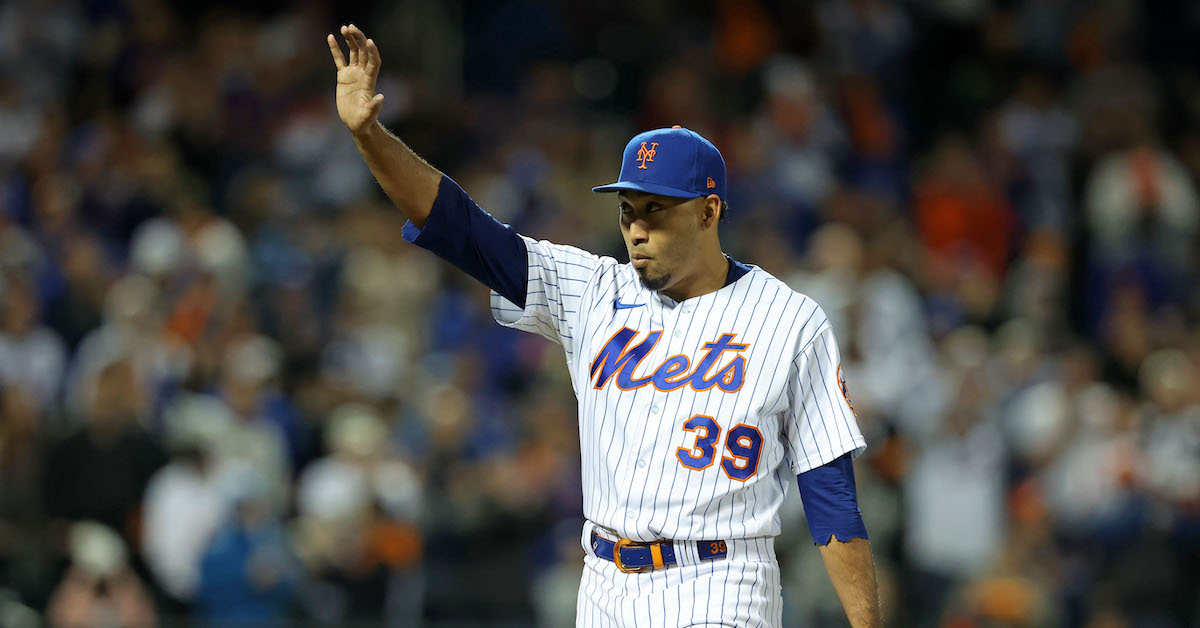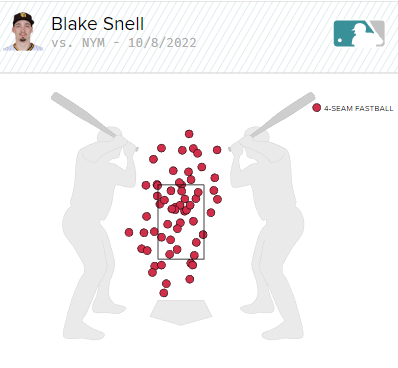Mets Force Game 3 Despite Questionable Bullpen Management

Coming into last night’s win-or-go-home game for the Mets, the biggest question concerned ace Jacob deGrom. In his last four starts of the season, he tossed 21 innings with an incredible 39-to-4 strikeout to walk ratio, but when he got hit, he got hit hard. He allowed 14 runs in those starts, mostly coming off of six home runs allowed, including three in his last start against Atlanta that ended up deciding the division. Perhaps more importantly, deGrom had averaged just 21.7 batters faced in the regular season, with abysmal results when facing the order a third time. While he looked like normal Jacob deGrom through his first 18 batters of any given start, he allowed a .936 OPS his third time through the lineup, with five homers in 42 plate appearances. What would the Mets do with deGrom if the game entered the later innings in a close situation?
Perhaps unsurprisingly, this exact situation occurred. After setting down the first seven batters in order while touching 101.8 mph on his fastball, Trent Grisham took a triple-digit heater on the outer edge deep into center field for a homer. But deGrom wasn’t out of the inning yet. He allowed Jurickson Profar and Juan Soto to reach base with two outs, but struck out Manny Machado on a perfect slider to escape the jam. deGrom got through the fourth inning unscathed, but it was clear that he didn’t have the near-robotic command that led him to historic success in 2021, especially on his slider. He spiked a few of them, and threw many more off the plate in noncompetitive locations.
Those command issues came into play as deGrom began the fifth inning by walking Grisham on five pitches, three of them sliders low and inside. After a successful sacrifice by Austin Nola, deGrom had to face the Padres’ lineup for the third time. Profar, the Padres leadoff hitter, saw four sliders in the same place before a fifth leaked out over the middle of the plate and singled, driving in the Padres’ second run of the game. The next batter, Soto, lined a 2-0 changeup down the pipe into right field for his second hit of the game. With runners on the corners and just one out in a tie game, deGrom was in a tight spot. But he kicked it back into gear after that. Four consecutive sliders perfectly located on the low and outside corner resulted in three swinging strikes from Machado, and deGrom ended the threat with a 99.4 mph fastball that got Josh Bell whiffing, his hardest-thrown pitch of the inning.
Meanwhile, opposing starter Blake Snell struggled from the beginning. With two outs in the first inning, Snell threw a slider right down the middle that had far less drop and horizontal movement than his season average, and Francisco Lindor capitalized with a 403-foot homer. After that, the command issues began. He allowed two walks before escaping the inning, but it didn’t stop there. After finishing the second and third innings unscathed despite traffic on the bases, he walked Eduardo Escobar and Darin Ruf to begin the fourth. After a swinging strikeout to catcher Tomás Nido, Brandon Nimmo hit a first-pitch single to left field for an RBI, ending Snell’s night. Despite only giving up two runs, he let 10 of the 19 batters he faced reach base and walked six Mets batters. His fastball location map shows that he had little feel for executing his pitches throughout his start:

But let’s go back to deGrom. Pete Alonso homered off Nick Martinez in the bottom of the fifth, giving the Mets a slim lead heading into the sixth. With deGrom at 90 pitches and 22 batters faced through five innings, manager Buck Showalter opted to let him stay in. This decision paid off, as deGrom set down the Padres in order with just nine pitches. While his overall feel for location was inconsistent and his fastball velocity dipped throughout the game, he was able to get big outs in high-leverage situations by relying more on his slider and changeup as the game went on. While 25 of deGrom’s 31 pitches his first time through the order were fastballs, he threw them just 44% of the time his second time through.
With deGrom done for the night — and perhaps seeking redemption from the 2016 AL Wild Card game — Showalter moved aggressively, bringing in closer Edwin Díaz in the seventh inning. While middle reliever Seth Lugo was seen warming up for parts of the previous innings, the Mets opted to bring in their relief ace. To my mind, this decision was clearly the right one. Lugo pitched in the Mets’ loss Friday and has consistently struggled in back-to-back appearances. In nine such outings this season, he has allowed opposing hitters an OPS over .900 with a 6.23 ERA, and his career 4.40 ERA in games without a day of rest is about a full run worse than his career ERA overall. The Mets could have gone to one of their other above-average relievers, but with the season on the line in a one-run game, going to your best pitcher seems natural. Díaz just became the fourth qualified reliever in history to strike out over half of batters faced, and having him enter in the seventh opened up the opportunity for him to pitch multiple innings. He had six appearances of longer than one inning in the regular season, but five of them came in the second half, possibly indicating the team’s willingness to ready him for a postseason situation like this. Díaz finished the inning without allowing any runs.
In the bottom of the seventh, the Padres turned to young lefty Adrian Morejon. Lindor led off the inning with a single, then Alonso battled Morejon for 10 pitches before drawing a walk; nine of those pitches were fastballs, and Alonso was able to foul off six of them. Then almost the exact same thing happened with Mark Canha, who saw 10 pitches, all fastballs this time, and wasn’t fooled by any of them. After fouling off a bunch of them and watching the rest go by, he took his free pass and loaded the bases. Morejon threw 26 pitches to face three batters. Twenty-three of those were fastballs, and the trio of Mets didn’t swing and miss at a single one. It seems difficult to justify Morejon’s usage in this spot against three righties with Pierce Johnson and Steven Wilson available and rested, and Robert Suarez, who had thrown just seven pitches in Game 1, seemingly a possibility as well. Regardless, Morejon stayed in to face lefty contact machine Jeff McNeil. In a 2-0 count with the infield in, Morejon threw — you guessed it! — a fastball, and McNeil sent a double past a diving Jake Cronenworth, extending the Mets’ lead to 5-2.
Morejon was replaced by Johnson, but the runs continued to pour on. Eduardo Escobar beat the shift with an opposite-field single and pinch-hitter Daniel Vogelbach hit a sacrifice fly, scoring McNeil. The seventh inning ended after nearly 45 minutes with the Mets up 7-2.
After that inning ended, I started writing, assuming this gamer would be about how an aggressive bullpen decision paid off and how the Mets’ timely hitting broke the game open, allowing them to cruise to victory. But then Showalter sent Díaz back out for the eighth. Despite the Mets now being up by five runs and Díaz sitting for the better part of an hour, he continued to pitch. He faced three batters, getting two outs and allowing a walk to Bell. Then Showalter made what was possibly an even stranger decision. He pointed to the bullpen and out came Adam Ottavino, easily the Mets’ second-best high leverage reliever behind Díaz. With Game 3 tomorrow, the Mets need all the available high-leverage pitching they can get.
Ottavino struck out Brandon Drury to end the inning, but after the Mets were set down in the bottom of the inning, he came back out. This time, things didn’t go so smoothly. He loaded the bases with two outs on a hit by pitch and a pair of walks before issuing an RBI free pass to Machado, bringing the tying run up to the plate. Showalter finally went back to the bullpen, summoning Lugo, who induced a game-ending groundout from Bell.
With a winner-take-all Game 3 this evening, Joe Musgrove will start for the Padres, while Chris Bassitt will take the mound for New York. On the bullpen side, though, San Diego appears to be better set up for the final showdown. Padres closer Josh Hader hasn’t pitched in the series, and Luis García and Robert Suarez are on a day of rest. On the Mets side of the ledger, meanwhile, Díaz and Ottavino combined to throw 63 pitches in Game 2, 44 of which came after New York had taken a big lead. It’s unclear how long they’ll be able to pitch tonight. And with Joely Rodríguez on the playoff IL, the Mets’ roster is now down to just one left-handed pitcher, David Peterson, and he’s more of a bulk arm than a lefty specialist. While the Mets’ hopes of advancing stayed alive on Saturday, their overuse of high-leverage relievers in a low-leverage situation may hamstring their ability to win Game 3 tonight.
Kyle is a FanGraphs contributor who likes to write about unique players who aren't superstars. He likes multipositional catchers, dislikes fastballs, and wants to see the return of the 100-inning reliever. He's currently a college student studying math education, and wants to apply that experience to his writing by making sabermetrics more accessible to learn about. Previously, he's written for PitcherList using pitch data to bring analytical insight to pitcher GIFs and on his personal blog about the Angels.

In the playoffs, unless you’re guaranteed another game, worry about tomorrow’s game tomorrow. No use saving a bullpen arm for tomorrow if tomorrow never comes.
Using Diaz to get through the heart of the Padres order was a smart move. If he’s needed in Game 3, I’m sure there will be second-guessing, but you have to get there first.
The Mets had a 1.3% chance of losing entering the top of the 8th. The impact of Diaz and Ottavino being unavailable in Game 3 has a larger impact on the Mets’ chances of winning in a close game. It’s not a “win today and figure the rest out tomorrow” situation, the Mets have to win both games to advance.
If there’s anything that watching Bobby Cox manage in the postseason taught me, it is that when facing elimination, it is ALWAYS a “win today and figure the rest out tomorrow” situation.
The second lesson is that everyone is in play when losing sends you home. Short rest, no rest, if the phone rings for you, you get ready to pitch with all you have. Diaz pitched 12 times in 2022 on 0 days rest and was used in Game 3.
At any rate, it wasn’t Buck Showalter’s questionable bullpen decisions that sank the Mets, it was their complete inability to score runs that did it.
Credit were credit is due: the SD pitching and defense had a little something to do with it, too. Sometimes you eat the bear, sometimes the bear eats you.
Credit San Diego’s offense as well. When a team’s 7-8-9 hitters outhit their 1-6 hitters, that also can spell trouble for the other side.
Really. You take lessons from watching Bobby Cox in the postseason?!? Every year the guy took the best team into the postseason (kudos to him there) and every year he lost with it. Every year but one, anyway.
Yes. They are generally lessons in what not to do.
Bobby Cox is a great example of a manager in the postseason managing like it is the regular season.